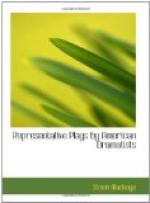A man to be a true actor must not only possess the power to portray vividly the emotions which in any given situation would be natural to himself, but he must study the character of the man whom he impersonates, and then act as that man would act in a like situation.
Mackaye’s devotion to Delsarte was manifest in the many practical ways he aided his teacher; he was rewarded by being left most of his master’s manuscripts. This passionate interest in the technique of acting not only enriched his own work, but, in 1872, prompted him to open a Delsarte house (the St. James Theatre), and later interested him in a school of acting. Mackaye studied at the Ecole des Beaux Arts and the Conservatoire, in Paris, having as an instructor at the latter institution M. Regnier. On his way back to America, Tom Taylor persuaded him to attempt Hamlet in London, at the Crystal Palace. This essayal met with success. It also opened the way for collaboration with Tom Taylor in the writing of “Arkwright’s Wife” and “Clancarty,” and with Charles Reade of “Jealousy.” At this time also he commenced a dramatization of George Eliot’s “Silas Marner.”
There were no half-way measures about Mackaye; things of the theatre and principles of the theatre caught and held his interest. At the very last of his life, while he was at work on his “Spectatorus,” which foreran the American idea of a Hippodrome, and which might have, in years to come, happily housed his son Percy’s “Caliban,” he was at the same time attempting to combine with it an educational aspect which would lift it above the mere spectacular. The symbolical notes which he handed his son—who was then a mere boy—for the writing of a Chorus, show the profound approach he took to all his work. Such seriousness is one of the consuming traits of Percy, whose sense of humour is probably better developed than that of his father, and whose sway of literary expression is fuller.
For none of Steele Mackaye’s dramas were written with any idea of being read. They were all constructed by one fully alive to the theatre and its demands. In view of this, it is surprising how well “Paul Kauvar” flows in type. The minor editorial changes made for this edition by Mr. Percy Mackaye are based on several manuscripts, and the result is the first authentic text of the play. Steele Mackaye was always gripped in fascination by mob psychology, always eager to write of the Reign of Terror. The version here used is the mature one, given its premiere at Buffalo, New York, May 30, 1887. But Mr. Percy Mackaye is authority for the statement that while his father was studying with Delsarte, in Paris, he became enamoured of the Revolution, and there are two manuscripts extant, “The Denouncer” and “The Terror,” which indicate that he was chipping away at his theme very early in life. He recast these sketches in the summer of 1875, while at Brattleborough, Vt., where he had a cottage on the Bliss Farm, familiar now to Rudyard Kipling lovers because of the fact that here, too, Kipling wrote, at a later day.




